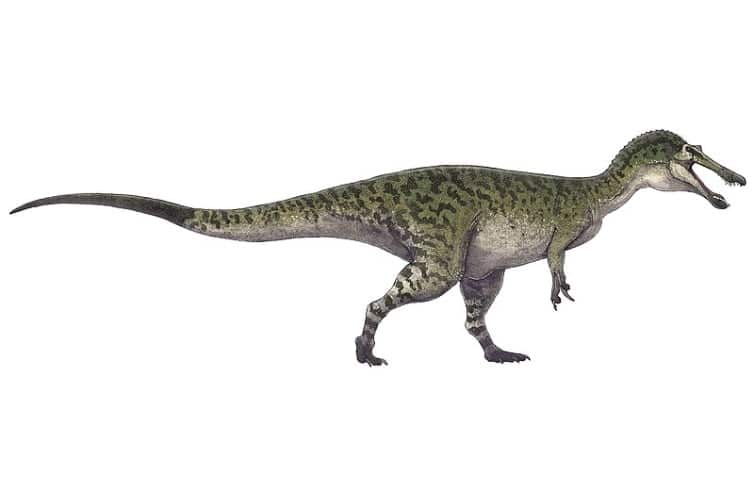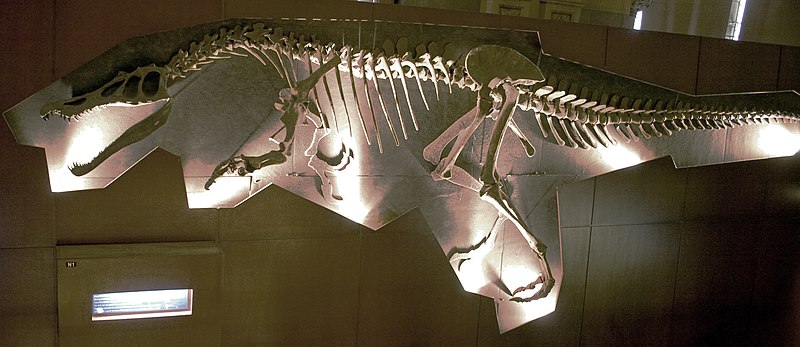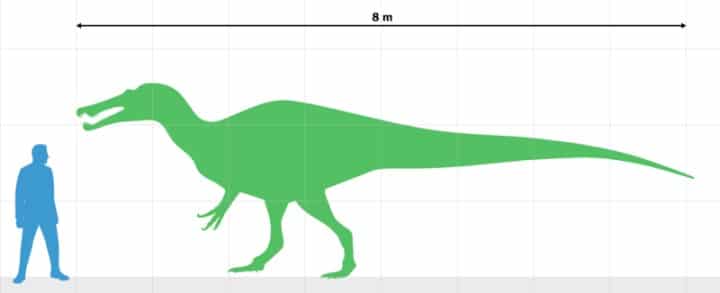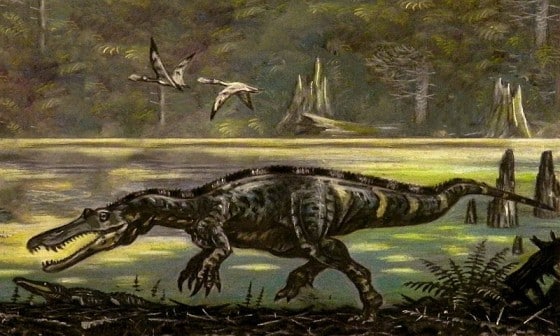In the realm of prehistoric creatures, the Baryonyx stands out as a unique and fascinating specimen. This dinosaur, whose name translates to “heavy claw,” roamed the earth during the Early Cretaceous period, leaving behind a legacy that continues to intrigue paleontologists and dinosaur enthusiasts alike. The Baryonyx is known for its distinctive features, such as its large claw and elongated snout, which set it apart from other dinosaurs of its time.
The Baryonyx’s story is one of discovery and exploration, as scientists continue to unearth new information about this dinosaur’s lifestyle, diet, and habitat. This article delves into the world of the Baryonyx, providing a comprehensive look at its origins, key facts, fossil evidence, and more. Join us as we journey back in time to the Early Cretaceous period, exploring the life and times of the Baryonyx.
Baryonyx Key Facts
| Keyword | Fact |
|---|---|
| Baryonyx pronunciation | Bahr-ee-on-iks |
| Meaning of name | Heavy claw |
| Group | Theropods |
| Type Species | Baryonyx walkeri |
| Diet | Carnivore |
| When it Lived | 140.2 to 113.0 MYA |
| Period | Early Cretaceous |
| Epoch | Late/Upper Valanginian to the top of the Aptian |
| Length | 25.0 to 33.0 ft |
| Height | 8.0 ft |
| Weight | 2.0 tons |
| Mobility | Moved on two legs |
| First Discovery | 1983 by William Walker |
| Location of first find | Surrey, England |
| First Described by | 1986 by Alan Charig and Angela Milner |
| Holotype | NHMUK VP R995 |
Baryonyx Origins: Taxonomy, Timeline, and Discovery

The Baryonyx, whose name means “heavy claw,” is a testament to the rich diversity of dinosaur species. The name is derived from the Greek words “barys” (heavy) and “onyx” (claw), a fitting moniker for this dinosaur that is known for its large, formidable claw.
In terms of taxonomic classification, this dinosaur belongs to the group of Theropoda, specifically the family Spinosauridae. This family is known for its members’ distinctive elongated snouts and conical teeth–traits that this dinosaur also possesses. Baryonyx walkeri, named after its discoverer, is the only known species of this genus.
It lived during the Early Cretaceous period during a time of significant change in the earth’s climate and geography, which likely influenced the Baryonyx’s lifestyle and diet.
The first fossil was discovered in 1983 in Surrey, England, by an amateur fossil hunter named William Walker. The dinosaur was later described by paleontologists Alan J. Charig and Angela C. Milner, who recognized its unique characteristics and established it as a new genus and species.
Listen to Pronunciation
Fossil Evidence
The first fossil was discovered in a clay pit in Surrey, England in 1983. This remarkable find included a nearly complete skeleton, making it one of the most complete theropod specimens discovered in the UK. The fossil showed distinctive features such as a large claw on the hand and an elongated snout which provided valuable insights into its physical characteristics and lifestyle.

Following the initial discovery, additional fossils have been found in various locations, including Portugal, Spain, Tunisia, and other parts of the United Kingdom. These finds have further enriched our understanding of this dinosaur, shedding light on its geographical range and possible migration patterns.
The fossils have been remarkably well-preserved, allowing scientists to study its anatomy in detail. Notable specimens include the dinosaur’s large claw, which is believed to have been used for hunting and possibly for defense against predators.
Baryonyx Size and Description
The Baryonyx is a dinosaur that commands attention, not just for its size, but also for its unique physical characteristics. Let’s delve into a more detailed description of this fascinating creature.
Short description of Baryonyx
This was a large theropod dinosaur with a body shape that was somewhat similar to that of a crocodile. It had an elongated snout filled with sharp, finely serrated teeth that were perfect for catching its preferred prey–fish. Its most distinctive feature was a large claw, about 31cm long, which it may have used to hook fish out of the water. This claw was probably found on its thumb. It moved on two legs and, while we don’t have a precise speed estimate, it was likely a capable predator and scavenger in its environment.
Size and Weight of Type Species

It was a sizable dinosaur. It measured approximately 33 feet in length and weighed around 2 tons. These estimates are based on the fossils that have been discovered so far and they place the Baryonyx among the larger theropods of its time. However, it’s important to note that these are estimates, and actual sizes could have varied.
The Baryonyx in Detail
This is a dinosaur that stands out for its unique features. Its large claw and elongated snout set it apart from other theropods, reflecting its adaptability and survival instincts. The large claw in particular is believed to have been a crucial tool for hunting that allowed the Baryonyx to catch fish with ease.
One of the most notable specimens is the one discovered by William Walker in 1983. This nearly complete skeleton has provided invaluable insights into the dinosaur’s physical characteristics and lifestyle. It has also helped to establish the Baryonyx as a distinct genus and species within the Spinosauridae family.
The Baryonyx’s distinctive features and adaptations reflect its unique lifestyle and diet. Unlike many other theropods, the Baryonyx was primarily piscivorous–a fish eater–as suggested by its crocodile-like snout and sharp, serrated teeth. This dietary preference sets it apart from other theropods which typically preferred to hunt terrestrial prey.
The Baryonyx in its Natural Habitat and Environment

This predator lived across Europe and Northern Africa during a time when the earth’s climate and geography were undergoing significant changes. The Early Cretaceous period was marked by warm temperatures and rising sea levels, which likely created a variety of habitats for dinosaurs like the Baryonyx to thrive in.
As a piscivorous dinosaur, its diet primarily consisted of fish. Its crocodile-like snout and sharp, serrated teeth suggest this lifestyle, as they would have been ideal for catching and eating fish. Its large claw may have also played a role in its hunting strategy, possibly being used to hook fish out of the water.
The lifestyle and behavior of this dinosaur are still subjects of ongoing research. However, based on its physical characteristics and the environments in which its fossils have been found, it’s likely that it was a capable predator and possibly a scavenger. It’s also possible that it was a solitary animal, although more research is needed to confirm this.
Interesting Points about Baryonyx
- Its large claw is one of its most distinctive features. This claw, which measured about 31 cm long, was likely used for hunting fish.
- Unlike many other theropods, it was primarily a fish eater. This is suggested by its crocodile-like snout and sharp, serrated teeth.
- The initial find is one of the most complete theropod specimens ever discovered in the UK. The nearly complete skeleton found by William Walker in 1983 has provided invaluable insights into this dinosaur’s physical characteristics and lifestyle.
- The fossils have been found in various locations, including Portugal, Spain, Tunisia, and other parts of the United Kingdom, suggesting a wide geographical range for this dinosaur.
Contemporary Dinosaurs
In the prehistoric world where this dinosaur reigned, it shared its environment with a fascinating array of contemporaries. Among these were Iguanodon, Hypsilophodon, Polacanthus, and Hylaeosaurus, dinosaurs that contributed to the intricate balance of life in their own ways.
The Iguanodon, an herbivore of considerable size, may have been a frequent sight for the Baryonyx. This dinosaur has a geographical range that also extends across Africa and Europe Their coexistence paints a picture of a landscape where the Baryonyx, a carnivore, might have viewed the Iguanodon as potential prey. Yet the Iguanodon was no easy target–its size and robustness would have made it a challenging pursuit. In contrast, the Hypsilophodon, considerably smaller than the Baryonyx, would have been a more accessible prey for the Baryonyx.
The Polacanthus and Hylaeosaurus, both herbivores and protected by body armor, introduce an interesting contrast. Their presence suggests a world where the Baryonyx would have had to strategize its hunts, navigating around these heavily armored contemporaries. This coexistence underscores the adaptability of the Baryonyx, a predator in a world of diverse and formidable contemporaries.
Frequently Asked Questions
It means “heavy claw,” a name derived from the Greek words “barys” (heavy) and “onyx” (claw).
It lived during the Early Cretaceous period, specifically between 130 to 125 million years ago.
This was a piscivore–a creature that primarily ate fish. This is suggested by its crocodile-like snout and sharp, serrated teeth.
The first fossil was discovered in Surrey, England, in 1983.
An amateur fossil hunter named William Walker discovered this dinosaur, which was later described by paleontologists Alan J. Charig and Angela C. Milner.
Sources
- https://www.nature.com/articles/324359a0
- https://cdnsciencepub.com/doi/10.1139/e93-183
- https://www.sciencedirect.com/science/article/abs/pii/S0031018207000302
- https://www.lyellcollection.org/doi/10.1144/0016-76492006-032
- https://www.cambridge.org/core/journals/geological-magazine/article/abs/spinosaurid-dinosaur-baryonyx-saurischia-theropoda-in-the-early-cretaceous-of-portugal/E2F9B7C099506CE2CD948E022FBDAD5E
This article was last fact checked:Joey Arboleda, 06-10-2023
Featured Image Credit: Lineart by Robinson Kunz, Color by Rebecca Slater, CC BY-SA 3.0, via Wikimedia Commons
